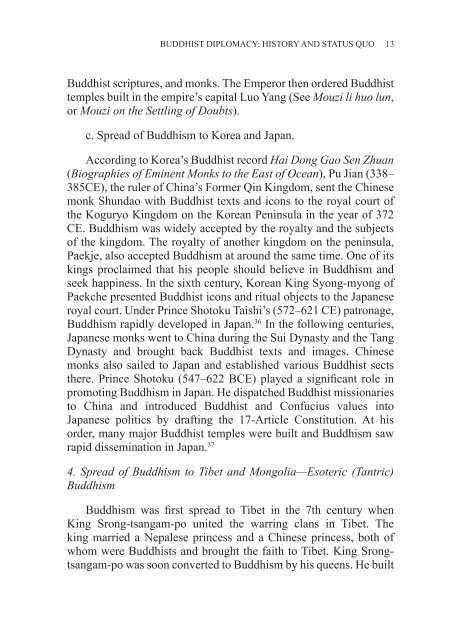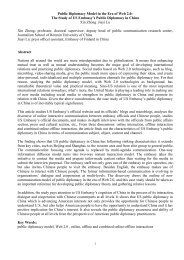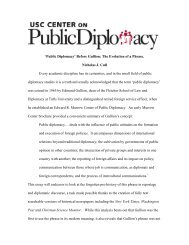Buddhist Diplomacy: History And Status Quo. - USC Center on ...
Buddhist Diplomacy: History And Status Quo. - USC Center on ...
Buddhist Diplomacy: History And Status Quo. - USC Center on ...
- No tags were found...
Create successful ePaper yourself
Turn your PDF publications into a flip-book with our unique Google optimized e-Paper software.
BUDDHIST DIPLOMACY: HISTORY AND STATUS QUO 13<str<strong>on</strong>g>Buddhist</str<strong>on</strong>g> scriptures, and m<strong>on</strong>ks. The Emperor then ordered <str<strong>on</strong>g>Buddhist</str<strong>on</strong>g>temples built in the empire’s capital Luo Yang (See Mouzi li huo lun,or Mouzi <strong>on</strong> the Settling of Doubts).c. Spread of Buddhism to Korea and Japan.According to Korea’s <str<strong>on</strong>g>Buddhist</str<strong>on</strong>g> record Hai D<strong>on</strong>g Gao Sen Zhuan(Biographies of Eminent M<strong>on</strong>ks to the East of Ocean), Pu Jian (338–385CE), the ruler of China’s Former Qin Kingdom, sent the Chinesem<strong>on</strong>k Shundao with <str<strong>on</strong>g>Buddhist</str<strong>on</strong>g> texts and ic<strong>on</strong>s to the royal court ofthe Koguryo Kingdom <strong>on</strong> the Korean Peninsula in the year of 372CE. Buddhism was widely accepted by the royalty and the subjectsof the kingdom. The royalty of another kingdom <strong>on</strong> the peninsula,Paekje, also accepted Buddhism at around the same time. One of itskings proclaimed that his people should believe in Buddhism andseek happiness. In the sixth century, Korean King Sy<strong>on</strong>g-my<strong>on</strong>g ofPaekche presented <str<strong>on</strong>g>Buddhist</str<strong>on</strong>g> ic<strong>on</strong>s and ritual objects to the Japaneseroyal court. Under Prince Shotoku Taishi’s (572–621 CE) patr<strong>on</strong>age,Buddhism rapidly developed in Japan. 36 In the following centuries,Japanese m<strong>on</strong>ks went to China during the Sui Dynasty and the TangDynasty and brought back <str<strong>on</strong>g>Buddhist</str<strong>on</strong>g> texts and images. Chinesem<strong>on</strong>ks also sailed to Japan and established various <str<strong>on</strong>g>Buddhist</str<strong>on</strong>g> sectsthere. Prince Shotoku (547–622 BCE) played a significant role inpromoting Buddhism in Japan. He dispatched <str<strong>on</strong>g>Buddhist</str<strong>on</strong>g> missi<strong>on</strong>ariesto China and introduced <str<strong>on</strong>g>Buddhist</str<strong>on</strong>g> and C<strong>on</strong>fucius values intoJapanese politics by drafting the 17-Article C<strong>on</strong>stituti<strong>on</strong>. At hisorder, many major <str<strong>on</strong>g>Buddhist</str<strong>on</strong>g> temples were built and Buddhism sawrapid disseminati<strong>on</strong> in Japan. 374. Spread of Buddhism to Tibet and M<strong>on</strong>golia—Esoteric (Tantric)BuddhismBuddhism was first spread to Tibet in the 7th century whenKing Sr<strong>on</strong>g-tsangam-po united the warring clans in Tibet. Theking married a Nepalese princess and a Chinese princess, both ofwhom were <str<strong>on</strong>g>Buddhist</str<strong>on</strong>g>s and brought the faith to Tibet. King Sr<strong>on</strong>gtsangam-powas so<strong>on</strong> c<strong>on</strong>verted to Buddhism by his queens. He built











